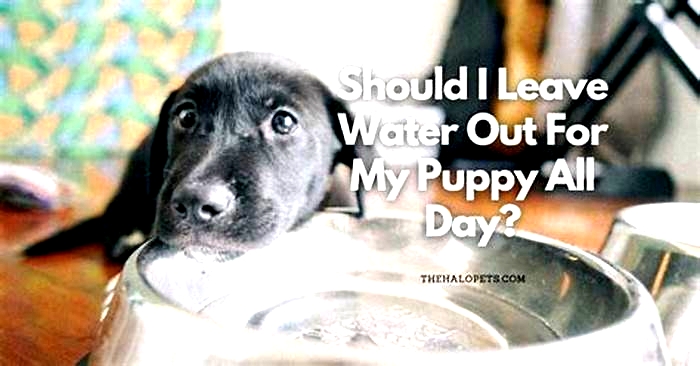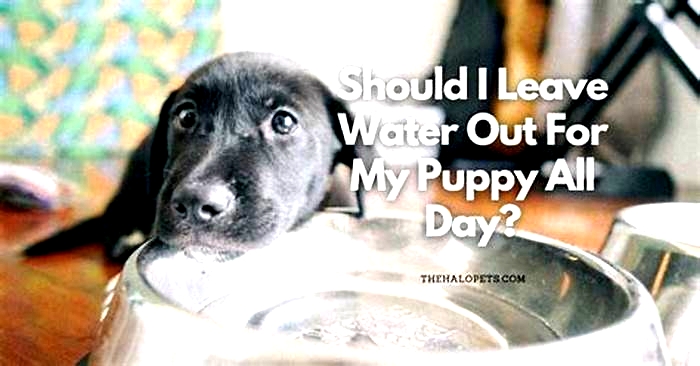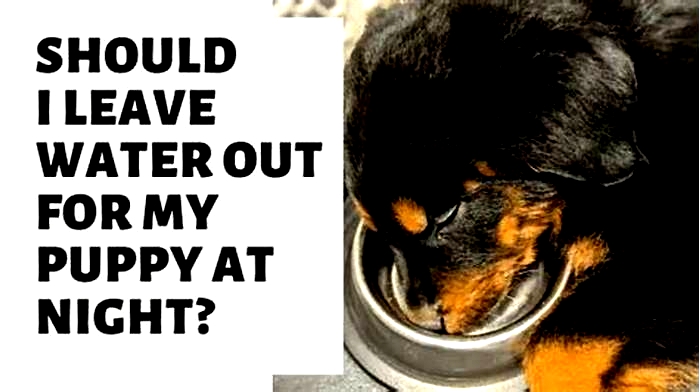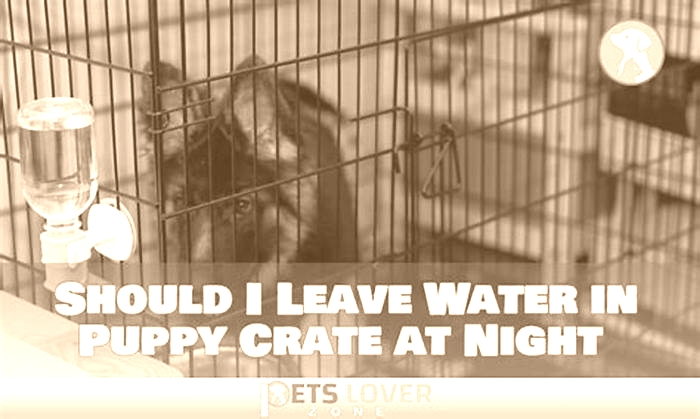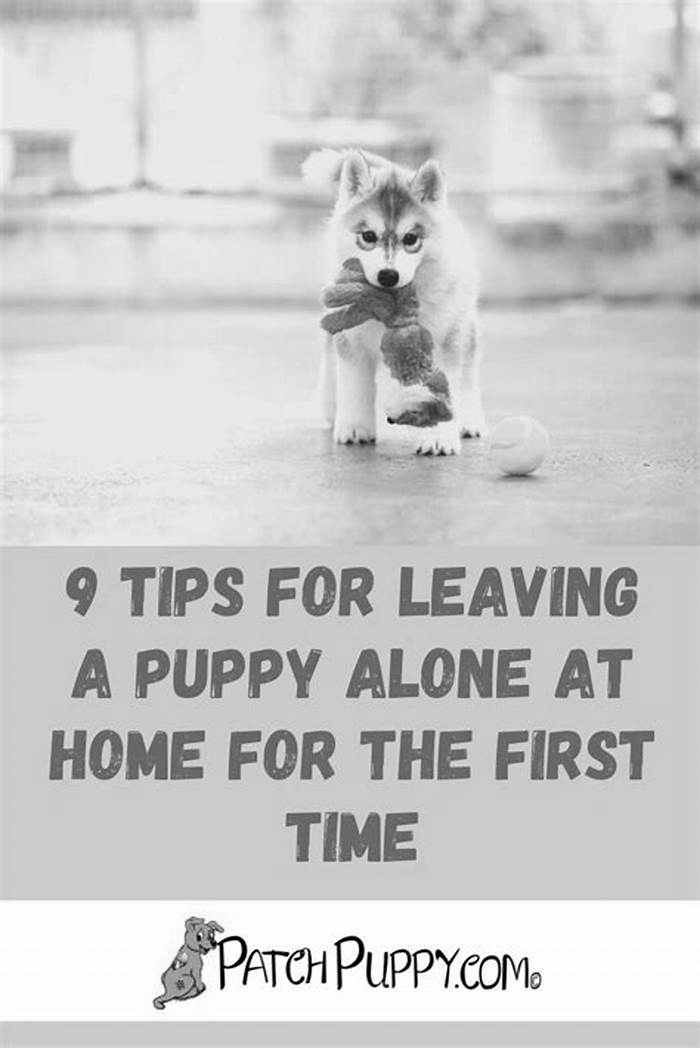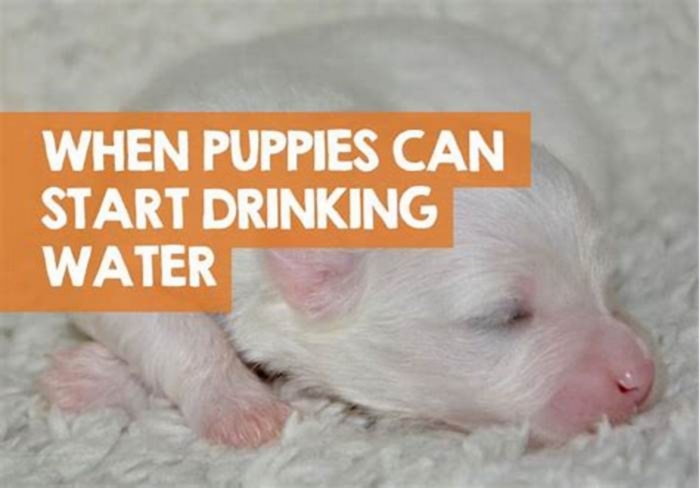Should I leave water out all day for my 8 week old puppy
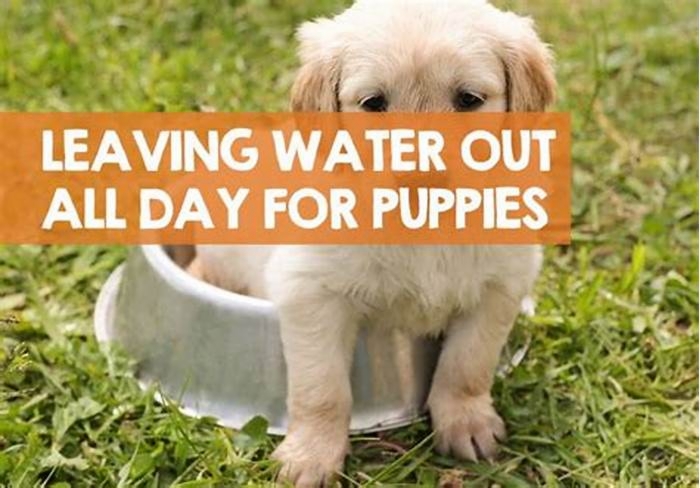
Should I Leave Water Out for My Puppy All Day?
Puppies are manic and with all that running around they do, can be at risk of becoming dehydrated. Evidently, they will need water, but it begs the question whether theres such a thing as too much, and whether you should keep water out for your puppy all day.
For example, it can be difficult to know if there are any risks associated with leaving water standing for long periods, or how regularly sources of water should be changed. Similarly, knowing how much water to leave out for your pup to avoid accidents in the house can be extremely useful, too.
Should I leave water out for my puppy all day? You should leave water out for your puppy all day, so they have access to it. However, the water should be changed twice a day for a clean supply, and the water bowl should be cleaned every 24 to 48 hours to avoid bacteria.
How to leave water out all day for your dog or puppy
Thats the very short answer above about leaving water out for your puppy or dog all day. But theres a bit more you should also know which Ive detailed below.
How often should I change the water in my puppys bowl?
Looking after a new puppy can often be stressful. Although most young dogs are able-bodied and sturdy, there are many factors to consider in keeping them happy and healthy.
Alongside providing them with regular exercise, we need to make sure our furry companions are receiving enough nutrition and water in their diets, as well as regular check-ups, grooming appointments, preventive measures for ticks and fleas, and the right amount of socialization.

Therefore, it can be easy to forget smaller tasks such as changing the water in our puppys bowls, keeping it fresh throughout the day. In colder weather, it also means taking measures to stop the water freezing, if its an outdoor bowl.
Unfortunately, when you leave water out for your puppy all day, the bowls can quickly become a breeding ground for bacteria without regular cleaning and the supply of new water.
Microorganisms present in your puppys saliva are often responsible for this change, being transferred to their water bowl each time they decide to take a drink and thereby causing bacteria to form.
Therefore, you should make sure to change the water in their bowls at least once a day to prevent this from happening. In addition, you should also make sure to thoroughly clean the bowl each time you do this.
Although some owners may think this is over the top, puppies can quickly become sick if they are exposed to bacteria-laden water.
Likewise, you should also make a habit of washing your pups bowl with hot soapy water (or stronger cleaning agents) once every 3 or 4 days, eliminating any chances of strong bacteria persisting after initial cleanings.
Furthermore, ensure that you sweep and mop any areas that your puppys bowls are located, together with washing any placemats the bowls are placed on. This is vitally important if you tend to feed your pup close to where it drinks from, as bacteria can quickly spread from food to water.
Doing so can also offer protection against other dogs in your household. Sometimes older dogs can urinate on or near water bowls when new puppies come into the home.
Typically, this happens when small pieces of food, sometimes lying undiscovered for days, are picked up by your puppy and transferred to their water bowls, leading to contamination.
For this reason, we recommend keeping standing water and food sources separate when possible.
Should I leave water out for my puppy during the night?
There is nothing fundamentally wrong with leaving your puppy without water overnight, it is perfectly safe to do so. In fact, this is sometimes essential to prevent your pup from having an accident in the middle of the night, especially if they are not house trained yet.
However, in particularly warm climates, puppies may occasionally wake up and search for water. If you reside in an area such as this, do not ignore your pups behavior as it could be dehydrated.
If this is a regular occurrence, you should leave water out for your puppy all day and night in a water bowl. Put it in a suitable area and try to create a spot where your puppy can pee safely in a spot of your choosing.
Similarly, always make sure that your pup has had a drink of water at least an hour or two before bedtime to prevent dehydration during the night. Unfortunately, most young puppies are unable to hold their urine for more than a few hours at a time.

Therefore, it is not unusual for puppies to need multiple potty breaks during the night even when they do not have access to water. For owners who crate their pups, waking up in the middle of the night is a regular occurrence.
Interestingly, there exists a semi-reliable way for owners to figure out how long their pups can hold their bladders. As a general rule of thumb, pups can hold their urine for the same number of hours as they are months old.
For example, a four-month-old puppy can normally hold its pee for 4 hours, and a 5-month-old pup around 5 hours. However, from time to time, and typically when they are exhausted, they may be able to hold their urine for longer periods.
How much water does a puppy need to drink per day?
Fresh cool water should always be made available for your puppy. As previously mentioned, puppies burn a lot of energy throughout the day and this activity plays a role in how much water they require to drink.
Puppies come in all different personalities, sizes, and breeds and this can sometimes affect how energetic or lazy they can be.
Therefore, less energetic pups will typically drink less water when compared to their high-energy siblings. This is entirely normal and should not cause you any concern.
Despite this, it is essential to take the current temperature and humidity levels of your area into consideration make sure to put out plenty of extra water when the weather turns hot, especially if you own several dogs.
In general, puppies recently weaned off their mothers milk require around 15 to 30ml water per pound of body weight per day to stay healthy.
Without access to this critical amount of fluid, puppies can be at risk of suffering from kidney damage and heart problems caused by dehydration, as well as heatstroke during the warmer months.
So long as fresh water is easily accessible, puppies will naturally drink when they are thirsty enough. However, in rare circumstances, some pups may refuse water entirely. If you notice this is the case with your pooch, take them to the vet as soon as possible. This could indicate that they are suffering from a serious medical condition.
Handy Hint: I dont advise giving puppies freedom of the house until they are 12 to 18 months of age, as I learned from my mistakes!
Can puppies drink too much water if you leave it out?
Although it is very important to ensure that your puppy does not suffer from dehydration, sometimes drinking too much water can be a bad thing for them.
Worryingly, many dog owners are unaware that the presence of dangerous quantities of water in their pups bodies can lead to severe illness and even death. On the flipside, some dogs wont drink enough water at all, but thats different problem.
Water intoxication, also known as water poisoning, water toxemia, and hyperhydration is a relatively rare condition that is most commonly seen in water-loving canines (where they inadvertently swallow water whilst swimming).
However, puppies can easily develop water intoxication just from spending too much time at their water bowls.
When a young canine is overwhelmed by water, its sodium levels drop which in turn causes swelling to occur throughout its cells. Some areas of the body can cope with this abnormal activity, but others, particularly the brain will struggle to function.
At this stage, water intoxication can quickly turn fatal. It is vital to get your puppy to the vet if they show any symptoms of water intoxication, no matter how small, as this condition progresses rapidly.
Similarly, you should also take your puppy to the vet if you notice they are drinking excessive amounts of water, as quick action can stop the condition from occurring in the first place. In most cases, excessive drinking can be treated without canines suffering any negative health issues.
Some of the most common symptoms of water intoxication to look out for are loss of coordination, bloating, vomiting, excessive salivation, seizures, glazed eyes, pale gums, and lethargy.
In worst-case scenarios, affected puppies can enter a comatose state, becoming unresponsive to touch and sound. Whilst at the vets, canines will be treated with a mix of IV delivery and administration of electrolytes, drugs, and diuretics to reduce brain swelling.
Conclusion
Ask any owner about their puppys strongest characteristics and they are likely to mention their seemingly never-ending amount of energy as one of the most defining.
Throughout the day, young pups keep themselves entertained by taking part in numerous vigorous activities like chasing their siblings around the home, playing with their toys, and running around the backyard.
Naturally, with this high level of activity comes an increased need for water. Without drinking regularly, puppies can quickly become dehydrated, leading to a whole host of health problems.
Thankfully, most dog owners are aware of this, and as such, they make sure to leave countless water bowls out for their furry companions to quench their thirst.
However, one question that puppy parents rarely ask themselves is whether leaving water bowls all day long is safe.
In my view, you can leave water out all day for your puppy, but closely monitor them.
You might also like
Image in header via https://pixabay.com/photos/puppy-golden-retriever-dog-young-1207816/
Should I Leave Water Out For My Puppy All Day? [Whats Ideal?]
If you have recently brought home a new puppy, you will likely have a lot of questions regarding their water intake and needs. Should you leave water out for your puppy all day? How much do they need to drink? How should you give your puppy water? Well, we are going to explore each and every one of these questions and provide the answers here today.
So, should you leave water out for your puppy all day?When a puppy is loose in your house or yard, it is best that they always have access to clean, fresh water and that multiple bowls are left out. Times you may want to control water access, however, are when a puppy is in a crate or an enclosed area where they cannot go freely to the toilet.
Puppies are good at regulating their own water needs, but when presented with water only occasionally, they may choose to quickly drink large amounts. This can lead to bathroom mishaps and even an upset stomach.
So, there are certainly times you want to limit access to water.
That being said, by and large, leaving water out for your puppy all day is generally a good idea.
With this in mind, lets take a closer look at your puppys water needs and how you can make sure they are met without any of the potential downsides free access can have!
How Many Times A Day Should I Give My Puppy Water?
When you are home with your puppy, it is in their best interest to have clean water available at all times. Most dogs will drink water when they need it and leave the water alone when they dont.
At times a puppy may choose to play in their water, but this behavior can usually be stopped by distracting them with a treat, toy, or other fun activity.
One reason to allow your puppy to choose when it drinks water is so that it takes in water naturally throughout the day.
If your puppy only receives water occasionally, you increase the chance that your puppy will try to rapidly drink a large amount of water at once.
Just like a human who drinks or eats too quickly, your puppy could get an upset stomach from water overload.
Not only will this lead to a mess for you to clean up, but it also means your puppy could end up more dehydrated than they were before they got their drink.
Providing your puppy water during the day isnt always as simple as pouring it in the bowl and leaving it to sit.
In order to help your puppy stay healthy, you will want to make sure that both the water and the bowl it is offered in are clean.
You will also want to replace the water once or twice during the day if possible.
Fresh water is more appealing to pets and will encourage your puppy to stay hydrated.
Times You May Want To Control Water Access
There are several times that you may want to control your puppys access to water for health, cleanliness, or training purposes.
Lets take a quick look at those times now.
Potty Training
Potty training a puppy is a careful balance of teaching your dog where to use the restroom and when to use it while also learning your puppys cues for needing to go outside.
During the day, you will want to give your puppy access to water and keep a close eye on its activities.
Puppies do not have large bladders, which means they usually need to use the restroom not too long after a good drink.
At night both pets and people need to learn to sleep soundly and without a ton of interruptions.
While a young puppy will need nighttime bathroom breaks, it is safe to lower the amount of water your puppy has during the evening and overnight hours to encourage good sleep habits.
Consider the time that you typically go to sleep, and then remove water for the night 1-2 hours before this time.
This means if you go to bed at 10:00 pm, it would be acceptable to pick up your dogs water dish around 8:30 pm, as long as they have it back by 8:00 the next morning.
Patiently teaching your puppy to go several hours overnight without water and bathroom breaks will lead to better sleep for the entire family.
When A Puppy Is In A Crate Or Carrier
Sometimes it is necessary to put a puppy in a crate, kennel, or carrier for a short period of time while we are away from home.
To help the crate area stay clean and comfortable, it is often a good idea not to give your puppy water inside their crate.
Young puppies will still need frequent breaks from their crate for using the bathroom and to get some exercise. This is a good time to offer a drink to your puppy as well.
While water is safe to give a puppy in a crate, it is very easy for a puppy to spill drinks in such a confined space.
Once the water is spilled, it cannot be drunk, and your puppy will find itself trying to snuggle up with wet bedding.
Also, water in a crate is easily contaminated with fur, dirt, and waste from puppy accidents.
Most puppies will be just fine in their crate for a period of time without water if it is available to them whenever they are free.
When A Puppy Is Having A Medical Procedure
Sometimes puppies need medical procedures such as spaying or neutering.
If your puppy is going to be having surgery or other medical procedure performed, check with your veterinarian about water access leading up to the visit.
Many veterinarians need to work with animals who have empty stomachs and bladders, so water may need to be taken away for a few hours leading up to the procedure.
How Long Can A Puppy Go Without Water During The Day?
Most puppies can go without water for 6-10 hours at a time before they start to become noticeably dehydrated. While a healthy puppycango this long, an active pup is best to get water at least once every four hours. The longer water-free period should be saved for the overnight hours when we want to encourage a puppy to sleep and rest.
There are some factors that may influence how long your puppy can go without water.
These factors include temperature, environment, activity level, and overall health.
A puppy who is in a location that is very hot and dry or running around spending a lot of energy is going to need water more frequently than one resting in a cool, calm environment.
A puppy who is unwell may need more water than normal. They may not want to drink and might need encouragement to stay hydrated.
If your puppy has been unwell and is going long periods without drinking when water is available, please call your veterinarian for assistance and advice.
How Much Water Should My Puppy Drink During The Day
The exact amount of water your puppy needs each day depends mostly on your puppys size measured by its weight. A safe rule to follow is to plan for your puppy daily to drink to 1 ounce of water for every pound they weigh. This means that if you have a 10-pound puppy, it will usually drink between 5-10 oz of water each day.
While you will want to keep an eye on your puppys water intake, you do not need to stress about measuring the exact amount of water out for your puppy each day.
Instead, provide several ounces of water consistently throughout the day and make sure your puppy is taking trips to the water bowl at least every couple of hours when you are home.
A puppy may drink more than the normal amount if they have been using lots of energy to run and play or if the weather is hot.
On the same note, they may have days where they drink a bit less than normal.
The best indicator of your puppys hydration is their behavior are they active and happy? and their need to use the bathroom.
If you notice your puppy is not urinating or is going much less than normal over the course of 24-48 hours, you may need to make sure they have access to clean water and are regularly drinking.
Best Ways To Offer Water To Your Puppy
When offering your puppy water, there are a few useful things to keep in mind. You should offer your puppy water in a consistent place, water should be offered in a bowl large enough for the puppy to drink but not deep enough for a small puppy to drown, and the water should be kept as clean and fresh as possible by refilling during the day.
Consistent Place(s)
Having water available to your puppy in a consistent and reliable place means your puppy will always know where to go when they feel thirsty.
You can offer water in more than one location, such as outdoors and indoors, but the most important thing is that your puppy is able to easily find it when they need it.
If your puppys water bowl is constantly on the move, it can be hard for them to find the bowl and stay hydrated.
Sufficiently Large Bowl
You want your bowl to be large enough to allow your puppy a good drink. Puppies, like young humans, are not always the most graceful of creatures.
They may spill and splash water as they drink.
This means they need a bit more water in their bowls than what you intend for them to swallow.
Also, a bowl that is heavy enough to not be tipped over if your puppy bumps or steps on it is useful to prevent you from having to fill the bowl after every drink your dog takes.
Consider Puppy Size
Please keep in mind your puppys size when selecting a bowl.
Most dogs do just fine with standard size bowls.
However, some breeds such as Chihuahuas and Miniature Poodles have extremely small puppies.
Make sure that your bowl holds water but isnt so deep that a stumbling puppy could drown or have other difficulties drinking.
Fresh, Clean Water
While a very thirsty dog will drink any water it can find, a puppy is more likely to drink water that is clean and fairly fresh.
The water doesnt need to be replaced every hour of the day, but filling the bowl in the morning and refreshing the water in the afternoon will encourage your puppy to keep drinking.
If the bowl or water becomes dirty, empty and clean the bowl.
Dogs that drink in parasites or tons of pollutants may struggle to stay healthy no matter how much water they drink.
Incentivize With Food
If you have a puppy that is nervous about using a water bowl, you can encourage them to give drinking a try by making sure the bowl is near their food.
You can also try placing a small amount of water in the bowl along with a treat (for a brief time).
Another option to try includes giving them water in fun forms such as ice cubes, that they can then play around with within their water bowl.
Finally
Water is vital for the health and well-being of puppies and mature dogs.
By making sure your puppy has clean water provided in a safe, accessible area of the home, you will be supporting your puppys wellbeing for life.
Limiting water at times is acceptable and sometimes helpful as long as your puppy has opportunities for frequent drinking during other parts of the day.
Have other questions related to your puppys water intake? Then give my other guides a read:
I am an experienced pet owner with decades of experience owning a number of different pets, from traditional pets like dogs and cats, to the more exotic like reptiles and rodents. I currently own a Cockapoo (pictured) called Bailey. I am also the main writer and chief editor here at Pet Educate; a site dedicated to sharing evidence-based insights and guidance, based on my vast pet ownership knowledge, experience, and extensive research.

